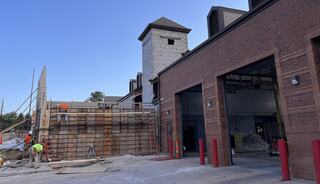
The Tree on Top: The Lore Behind the Topping Out Ceremony During Construction
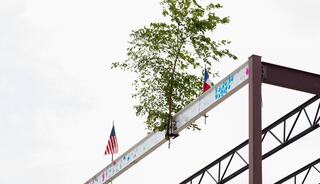
A Reflection as Houston Elementary School Tops Out
Have you ever looked up at a construction site and spotted a lone tree perched on a steel beam? No, it’s not a holiday leftover or an offbeat attempt at rooftop landscaping — it’s a time-honored tradition known as the topping out ceremony. That quirky little tree carries a lot of meaning, with a backstory that blends old superstition, cultural rituals and a deep respect for the people and processes behind construction.
Reaching the Highest Point
The topping out ceremony marks a major milestone in any building project: the moment when the structure reaches its highest point. In the world of construction, this is no small feat. It signals that the building’s bones are complete, the framework is up and it’s time to shift from steel and concrete to skin and systems.
The topping out also represents a moment of collective pride. It’s a chance for the entire team — from ironworkers and masons to project managers and architects — to pause and celebrate the reality of a design coming to life.
And as for the tree? Let’s dig into that.
Scandinavian Roots (Literally)
The tradition of placing a tree atop a structure has its origins in Scandinavian and Norse cultures, dating back over a thousand years. Builders would hoist a tree to the peak of a completed structure as a gesture of respect to the forest spirits displaced during construction. It was both an offering and an apology to nature, a way to spiritually bless the structure and those who would dwell within it.
The tree — usually a spruce or pine — symbolized life, growth and continuity, which made it a fitting emblem for a new building. The evergreen aspect was particularly meaningful: a tree that remained green through the seasons was seen as a sign of ongoing vitality and protection.
From Myth to Milestone
As the tradition spread across Europe and Asia and into North America, it evolved to fit local customs while keeping its core symbolism intact. In Germany, it's called Richtfest, often celebrated with wreaths, speeches, beer and hearty toasts to the workers. The beam may even be blessed by a local dignitary. In the Netherlands, similar traditions involve music and celebratory lunches.
In Japan, the topping out tradition takes on a sacred tone through the Jotoshiki ceremony, rooted in Shintoism. During Jotoshiki, Shinto priests bless the framework of a building with purification rituals, offerings of sake and rice, and symbolic prayers. The ritual emphasizes respect for nature, craftsmanship and the divine forces believed to dwell in the structure.
In China, a similar practice sometimes involves red ribbons, fireworks or attaching calligraphy scrolls to the building to ward off misfortune and invite good luck. These customs connect the act of construction to their culture’s deep-rooted beliefs in harmony and balance.
In the United States, the topping out ceremony has become a cultural staple on job sites of all sizes, and especially for civic, institutional and commercial projects. While not all ceremonies are elaborate, many include:
- A signed beam, often with names of the project team and the intended users
- A flag, most commonly the American flag
- A company banner or school insignia
- And of course, the iconic evergreen tree
The ceremony is a unifying moment in an industry that’s often segmented by trade, timeline or task. And it’s proof that, across cultures and continents, people have always found ways to celebrate the art and effort of building.
Construction Karma: A Bit of Superstition Never Hurts
Talk to enough general contractors, and the message is clear: never skip the tree. Even if there’s no formal event, even if no one's watching, the tree goes up. Why? Because in a field defined by strict deadlines and the occasional unexpected challenges (like an undocumented underground pipe), it never hurts to stay in the universe’s good graces.
In many ways, the tree acts as a quiet guardian. It anchors tradition in an industry driven by progress. If, in fact, hoisting a bit of greenery leads to smoother inspections, fewer change orders or good weather on pour day, who wouldn’t take that deal?
Recent Topping Out Ceremony Marks Milestone for Austin ISD
Austin Independent School District’s Houston Elementary School held its beam signing on Wednesday, Aug. 20, 2025 and the Topping Out Ceremony occurred on Thursday, Aug. 21, 2025. FGMA project team members wrote words of encouragement and hope on the final beam right next to students’ handprints and names.

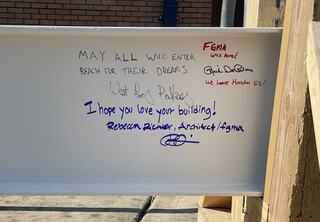
"Getting to share this tradition with students and staff was incredible," said FGMA Project Manager Jason George. "It really brought to life how the work we do on site will directly impact the place where they can learn, grow and succeed together."
FGMA designed the modernized school with significant engagement and input from the Campus Architectural Team, comprised of parents, teachers and community members.
Construction on the school includes distinct learning neighborhoods (classrooms of a certain grade grouped together): the Nest, the Woods and the Sky. Connection to the outdoors continues throughout the school's holistic design, evident in the material selections and generous interior natural light. This concept is echoed in the interior courtyard space for outdoor learning, a pollinator garden, walking trails, play areas and shade trees.
Construction is estimated to be complete before the start of the 2026-2027 school year.
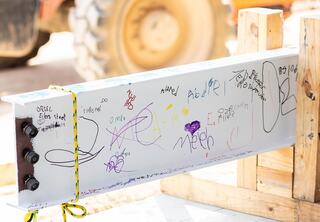
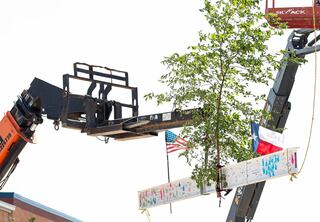
Learn More:
Houston Elementary School Project Overview
Pros and Cons of Three Construction Delivery Methods
Thank you to Rogers-O'Brien Construction for sharing their images from the topping out ceremony!
News & Insights
All Articles

Winning the Vote: How to Run a Successful Recreation Facilities Referendum
